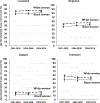Disparities in cervical cancer survival in the United States by race and stage at diagnosis: An analysis of 138,883 women diagnosed between 2001 and 2014 (CONCORD-3)
- PMID: 34454725
- PMCID: PMC11075792
- DOI: 10.1016/j.ygyno.2021.08.015
Disparities in cervical cancer survival in the United States by race and stage at diagnosis: An analysis of 138,883 women diagnosed between 2001 and 2014 (CONCORD-3)
Abstract
Objective: During 2000-2014, age-standardized five-year net survival for cervical cancer was 63-64% in the United States. Using data from CONCORD-3, we analyzed cervical cancer survival trends by race, stage and period of diagnosis.
Methods: Data from 41 state-wide population-based cancer registries on 138,883 women diagnosed with cervical cancer during 2001-2014 were available. Vital status was followed up until December 31, 2014. We estimated age-standardized five-year net survival, by race (Black or White), stage and calendar period of diagnosis (2001-2003, 2004-2008, 2009-2014) in each state, and for all participating states combined.
Results: White women were most commonly diagnosed with localized tumors (45-50%). However, for Black women, localized tumors were the most common stage (43.0%) only during 2001-2003. A smaller proportion of Black women received cancer-directed surgery than White women. For all stages combined, five-year survival decreased between 2001-2003 and 2009-2014 for both White (64.7% to 63.0%) and Black (56.7% to 55.8%) women. For localized and regional tumors, survival increased over the same period for both White (by 2-3%) and Black women (by 5%). Survival did not change for Black women diagnosed with distant tumors but increased by around 2% for White women.
Conclusions: Despite similar screening coverage for both Black and White women and improvements in stage-specific survival, Black women still have poorer survival than White women. This may be partially explained by inequities in access to optimal treatment. The results from this study highlight the continuing need to address the disparity in cervical cancer survival between White and Black women in the United States.
Keywords: Cancer stage; Cervical cancer; Inequalities; Race; Survival.
Copyright © 2021 Elsevier Inc. All rights reserved.
Conflict of interest statement
Declaration of Competing Interest The authors declare no conflicts of interest.
Figures



References
-
- U.S. Cancer Statistics Working Group, U.S. Cancer Statistics Data Visualizations Tool, based on November 2019 submission data (1999–2017), Available from URL www.cdc.gov/cancer/dataviz.
-
- Curry SJ, Krist AH, Owens DK, et al., Screening for Cervical Cancer: US Preventive Services Task Force Recommendation Statement, JAMA. 320 (2018) 674–686. - PubMed

